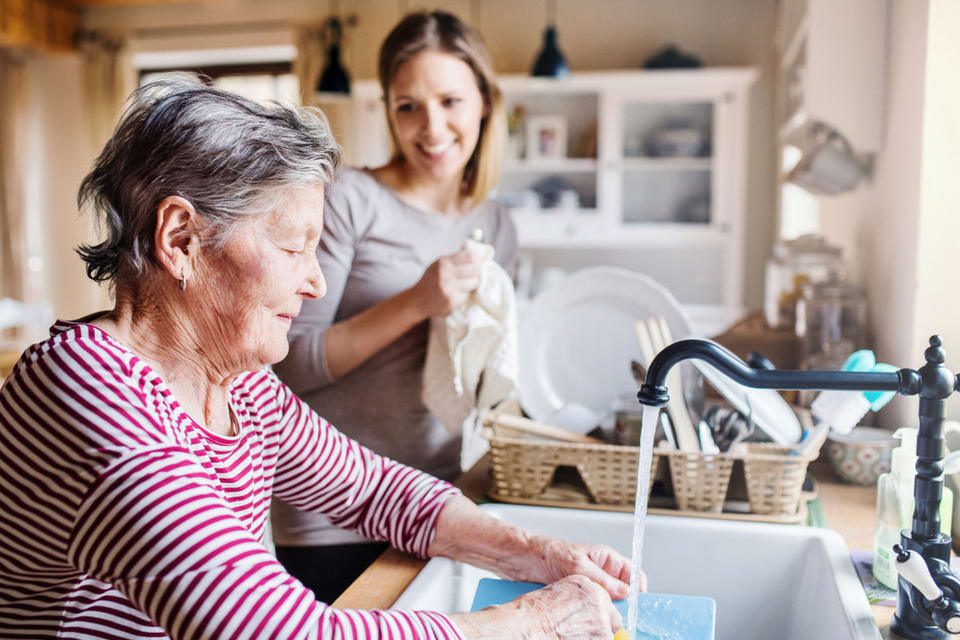Make the best senior care decision

Activities of Daily Living Checklists for Seniors

Cleaning your home, preparing dinner, and taking a shower are essential activities of daily living, or ADLs, that feel like second nature to many of us. But as we age, it’s normal for these tasks to become more and more difficult to perform. If you’ve noticed your loved one has had trouble completing these key life tasks, it may be a signal that it’s time for a major change in care.
Let our care assessment guide you
Our free tool provides options, advice, and next steps based on your unique situation.
In this Article
Learning the proper level of care for your aging parent is simple with the right guidance. To make an informed decision about your loved one’s care needs, read on to familiarize yourself with these key terms and related skills. You will also find ADL and IADL checklists that will help you assess your loved one’s well-being.
What are activities of daily living (ADLs)?
ADLs are basic tasks a person needs to be able to do on their own to live independently. Health issues and aging may make it difficult for seniors to complete certain everyday self-care tasks that are essential to keep them healthy and safe.
Basic ADLs, as outlined by the Katz Index of Independence in Activities of Daily Living, include six essential skills:
- Bathing and showering — the ability to bathe and maintain personal hygiene, which can include tasks like brushing teeth, combing hair, and nail care
- Continence— having complete control of bowels and bladder
- Dressing — the ability to select appropriate clothes and outerwear for the weather or occasion, and to get dressed independently
- Mobility — being able to walk or transfer from one place to another, specifically in and out of a bed or chair
- Feeding (excluding meal preparation) — the ability to get food from plate to mouth, and to chew and swallow
- Toileting — the ability to get on and off the toilet and clean one’s self without assistance
What are instrumental activities of daily living (IADLs)?
Instrumental Activities of Daily Living, or IADLs, are activities you do to care for yourself, your family, and your home. While ADLs are very fundamental, IADLs refer to more complex activities often involving more thinking and organizational skills that help a senior live and function independently. IADLs, as outlined by the Lawton-Brody scale, include:
- Cleaning and housekeeping — including maintenance and other home-care chores
- Doing laundry
- Managing money
- Managing medications and taking medicines as directed
- Preparing meals
- Shopping for groceries and other necessities
- Transportation, including changing residences and moving
- Using communication devices, including the telephone or computer
Why are ADLs and IADLs important for caregivers?
As a family caregiver, you have the power to give your loved one the best life possible. When you track your loved one’s health and functional capabilities, it will become easier to notice signs of deterioration and improvement. Knowing what ADL and IADL changes to look for will help you know what level of care your loved one needs.
Understanding the functions of ADLs and IADLs can help you take note of what activities of daily living your loved one can and cannot do. Ideally, they should have the physical and mental capabilities to conceptualize and carry out the tasks on their own or with minimal assistance.
Changes in these capabilities occur gradually over time. Often, a decline in the ability to complete basic ADLs may not be noticeable until later stages of physical or mental disability.
Knowing your loved one’s ability to complete ADLs and IADLs can help you, with the input of a doctor, answer the following questions:
- Do you or a neighbor need to check on your aging parent routinely?
- Does your aging loved one need physical therapy?
- Is your aging parent able to continue living independently?
- Would moving to an assisted living community eliminate chores and tasks that frustrate or are beyond your loved one?
ADLs can also help caregivers and health care professionals understand the level of care needed. The level of care for someone who can’t complete IADLs is different from the care needed by someone who can’t complete basic ADLs.
As you track your loved one’s status and plan for future steps, keep in mind that ADLs require more intensive, hands-on care. In some cases, IADL deficiencies may be managed by different service providers, such as a senior meal preparation or delivery service, a housekeeper, or a money management professional.
Families rarely ask about ADLs until a parent or senior loved one is going through the process of assessment for long-term care, says Dr. Leslie Kernisan, a geriatric expert.
“If someone is concerned about their mom, then knowing how they’re doing with ADLs is important,” she says. “It can educate a person and take them from feeling like ‘Mom needs help, I’m worried,’ to be able to answer questions like, ‘Okay, where does she need help?’”
She recommends bringing up changes in a loved one’s ability to do these tasks when talking with a physician.
According to Kernisan, it’s a good idea to share changes in ADLs with your loved one’s medical team. Before your next clinician visit, consider the following:

Let our care assessment guide you
Our free tool provides options, advice, and next steps based on your unique situation.
- A change in the ability to perform ADLs can trigger medical evaluations that may uncover a medical issue. It’s important to understand the root cause of the problem or change in ability.
- Understanding root causes can help you and your loved one’s doctor work together to find ways to improve function. Some common ways to improve function include medical treatment, physical therapy, or a device such as a walker.
- Understanding ADLs is critical to having an accurate care plan. If your parent’s doctor doesn’t realize there’s a functional problem, the care plan they create may not be in line with your loved one’s abilities. For example, if the doctor isn’t aware that your loved one is sometimes forgetful, then their expectation that your parent can regularly monitor their blood sugar on their own may not be realistic.
How are ADLs and IADLs assessed?
ADLs and IADLs can be assessed in a variety of ways. Caregiver input can be helpful to create a bigger picture of your loved one’s functional capabilities. However, caregiver burnout, the tendency to overestimate or underestimate someone’s true abilities, or a change in the caregiver’s ability to provide adequate care can make this method less accurate than others.
Self-reporting can also help get the conversation about ADLs started. No one understands a situation better than the person experiencing it. Self-reporting is especially helpful when individuals have minimal cognitive decline. However, self-reporting can introduce bias as your loved one may not feel an incident is really worth recording.
While a health care professional’s report is often believed to provide the most objective view of a person’s functional status, a combination of assessments may fully capture the picture of disability for a given individual.
The 3 types of ADL assessments physicians use
Health care professionals commonly use these tools to assess ADLs:
- The Katz Index of Independence in Activities of Daily Living.This is the best choice for patients in long-term care, where disability is generally more severe, but stable. In this assessment, you gain one point for each ADL your loved one can complete independently. The total number points you have tallied at the end of the assessment is indicative of how independent your loved one is and what level of care they may need.
- The Barthel ADL Index.This assessment covers two additional domains, including grooming and stairs. It’s best suited to acute care settings as it is more detailed and better detects subtle changes in a person’s health. In this assessment, the task levels are on a scaled point system. Similar to the Katz assessment, the more points you have in total, the more independent your loved one likely is.
- The Functional Independence Measure (FIM).This option is more comprehensive, combining ADLs with IADLs and other social domains. This assessment tool comprises 18 items divided into motor and cognitive categories. Each item is scored on a scale. The higher the score, the more independent your loved one is at performing the task.
Keep track at home
To help you assess and monitor your loved one’s activities of daily living, download A Place for Mom’s ADL and IADL checklists. These are great tools to take with you the next time your loved one has a medical check-up.
As you assess your loved one’s ability to complete ADLs and IADLs, follow these tips:
- Ask for other opinions. Check with siblings, neighbors, and friends. Inquire about any changes you’ve noticed in your loved one’s abilities. Pick two or three people to discuss your concerns with.
- Assess on a spectrum. Ask yourself whether your loved one can do the task a little bit, sometimes, or often rather than a simple “yes, they can do the task,” or “no, they can’t.”
- Be patient. “If a person is doing a task more slowly than they used to, it doesn’t mean they can’t do the task,” says Kernisan.
- Consider the time of day and how tired they are. Many seniors have sharper cognitive abilities and more energy in the morning.
- Consider their health. If they’re fatigued or fighting a virus, your loved one’s abilities can be momentarily impaired.
- Find the time. “It’s common to be in a hurry, and it’s difficult to find the time to observe, but it’s important to take the time, and when you do, be patient,” Kernisan says.
- Look at your own preconceived notions about your loved one. Are they interfering with your ability to make an impartial assessment?
- Make the effort to help correct what you can. Ensure your loved one can live life to the best of their abilities and as independently as possible.
“It’s very challenging to have people see you as less able,” Kernisan says. Caregivers should “be discreet and empathetic” when assessing for ADLs, she suggests.
If your loved one is unable to perform daily ADLs and IADLs, or if you have other safety concerns, it may be time to discuss increasing their level of support or moving to an assisted living community.
Signs that it’s time to assess ADLs and IADLs
Kernisan suggests keeping an eye out for specific safety factors when visiting a senior relative.
- Driving: Have there been any accidents or close calls? Do passengers feel worried?
- Elder abuse: Do you have any concerns about emotional, financial, physical, or verbal abuse?
- Finances: Are there problems paying bills? Are you concerned about scams?
- Health: Has your loved one had any falls? Have there been repeated trips to the ER or hospital?
- Memory and thinking: Have there been problems with forgetting, getting lost, or wandering? Is there concern about poor awareness or poor judgment?
If you answered “yes” to any of the above questions, it may be time to assess your aging loved one’s ADLs and IADLs, either by a medical professional or from your perspective as a family member.
Navigating changes
When it comes to assessing ADLs and IADLs, there’s a lot of technical information about different assessments. This can be overwhelming for families to navigate.
Dr. Kernisan understands this struggle and recommends the following:

Talk with a Senior Living Advisor
Our advisors help 300,000 families each year find the right senior care for their loved ones.
- Ask your aging parent’s doctor if a change in medical plan is required as their ability to complete ADLs decreases. For example, a complicated diabetes plan may need to be revised.
- Ask if your loved one qualifies for a service like Medicaid.
- Ask what’s causing any issues or inabilities.
- Be aware of your loved one’s true abilities when it comes to ADLs and IADLs.
- Consider whether the limitations have short- or long-term implications.
- Help your loved one remain independent as long as possible with adaptive assistance.
- Seek treatment.
How to get help with ADLs for your loved one
If you’re worried about your loved one’s ability to perform everyday tasks, connect with their doctor to discuss your concerns. It’s important to identify any limitations your aging parent may have, but it’s even more critical to support them by finding solutions to help solve or alleviate those limitations, or by finding the care they need.
Taking these steps will help your loved one to be as independent as possible so they can enjoy a greater quality of life.
In some cases, simple lifestyle adjustments such as hearing or vision aids, physical therapy, or assistive devices to make bathing, transferring on and off furniture, or using the toilet easier can help your loved one perform ADLs independently.
If your aging parent needs additional help, consider reaching out to an A Place for Mom Senior Living Advisor to find the level of care that fits your loved one’s needs.
The information contained in this article is for informational purposes only and is not intended to constitute medical advice or diagnosis. Always seek the advice of your physician or other qualified health care provider regarding any medical condition or treatment, and never disregard professional medical advice or delay treatment based on anything you have read on this site.Links to third-party websites are only for the convenience of the reader; A Place for Mom does not offer blanket endorsements of the contents of third-party sites.
Sources
Graf, C. (2008, April). Lawton-Brody Instrumental Activities of Daily Living Scale (IADL).
Liebzeit, D., King, B., & Bratzke, L. (2018). Measurement of function in older adults transitioning from hospital to home: An integrative review. Geriatric Nursing.
Linacre JM; Heinemann AW; Wright BD; Granger CV; Hamilton BB. (n.d.). The structure and stability of the functional independence measure. Archives of Physical Medicine and Rehabilitation.
McCabe, D. (n.d.). Katz index of independence in activities of daily living (ADL). Hartford Institute for Geriatric Nursing.
The National Palliative Care Research Center. (n.d.) Measurement and Evaluation Tools.
Williams, E. I., & Wallace, P. (1993, April). Health checks for people aged 75 and over. Occasional paper (Royal College of General Practitioners).
The information contained in this article is for informational purposes only and is not intended to constitute medical, legal or financial advice or create a professional relationship between A Place for Mom and the reader. Always seek the advice of your health care provider, attorney or financial advisor with respect to any particular matter and do not act or refrain from acting on the basis of anything you have read on this site. Links to third-party websites are only for the convenience of the reader; A Place for Mom does not recommend or endorse the contents of the third-party sites.